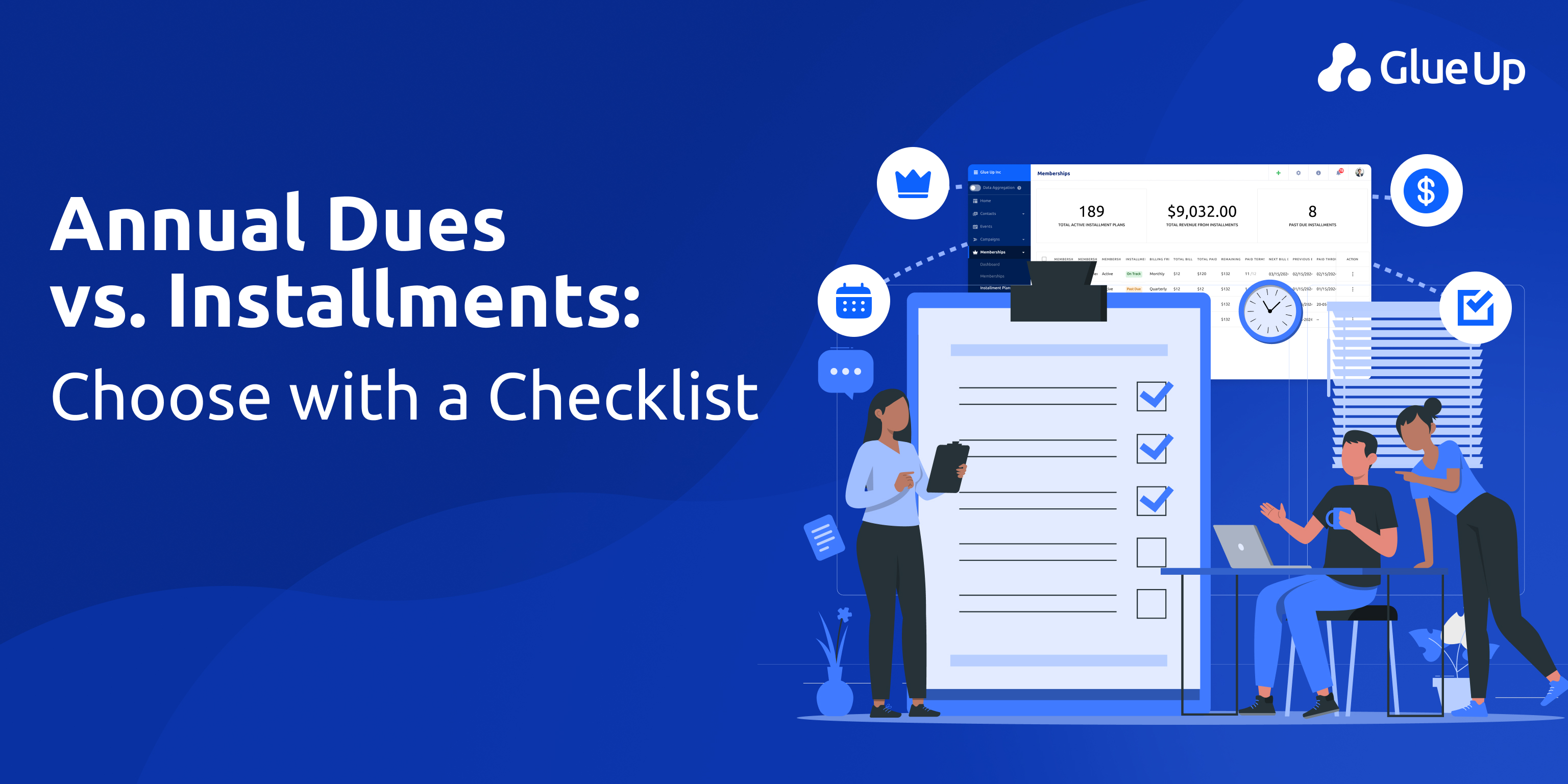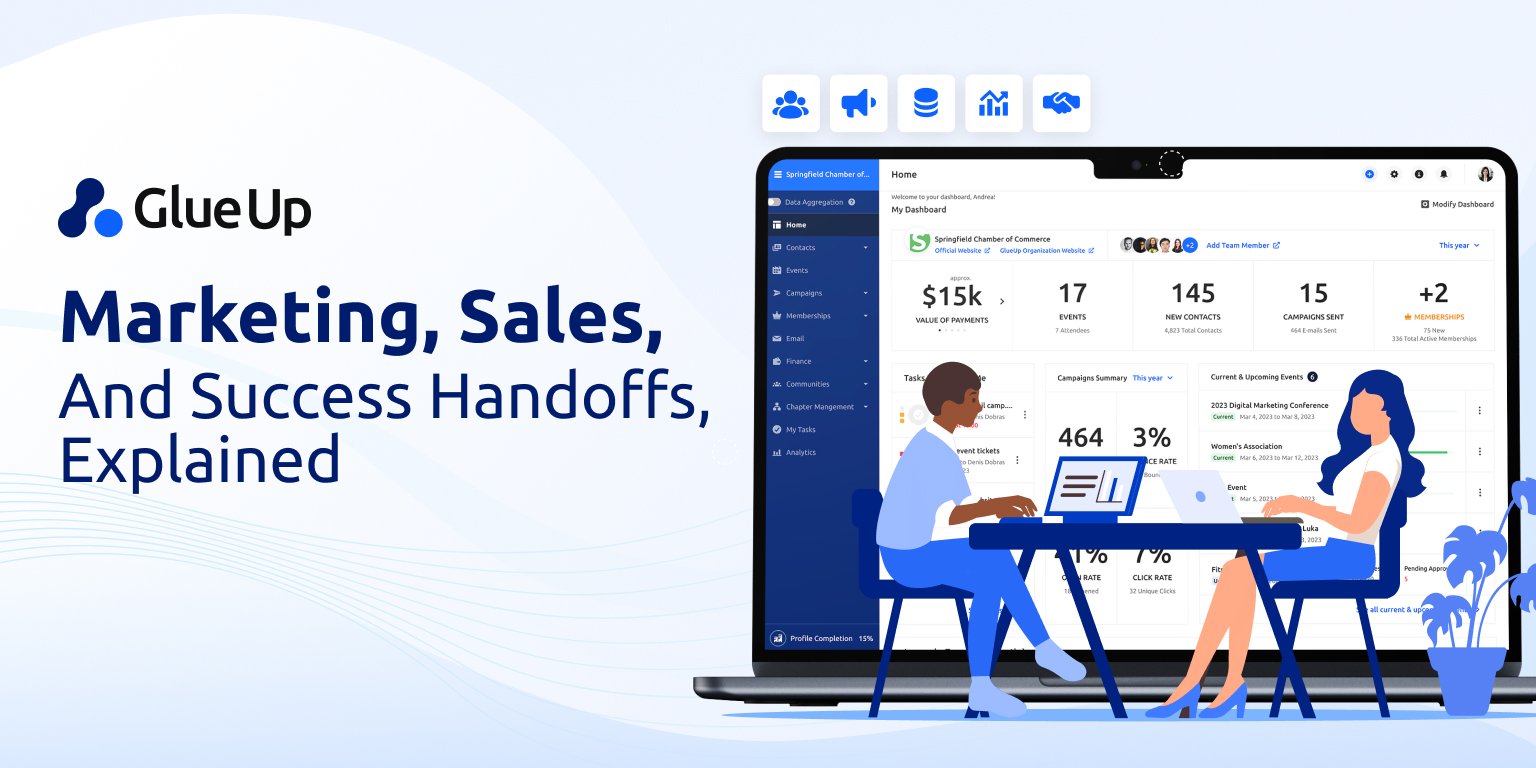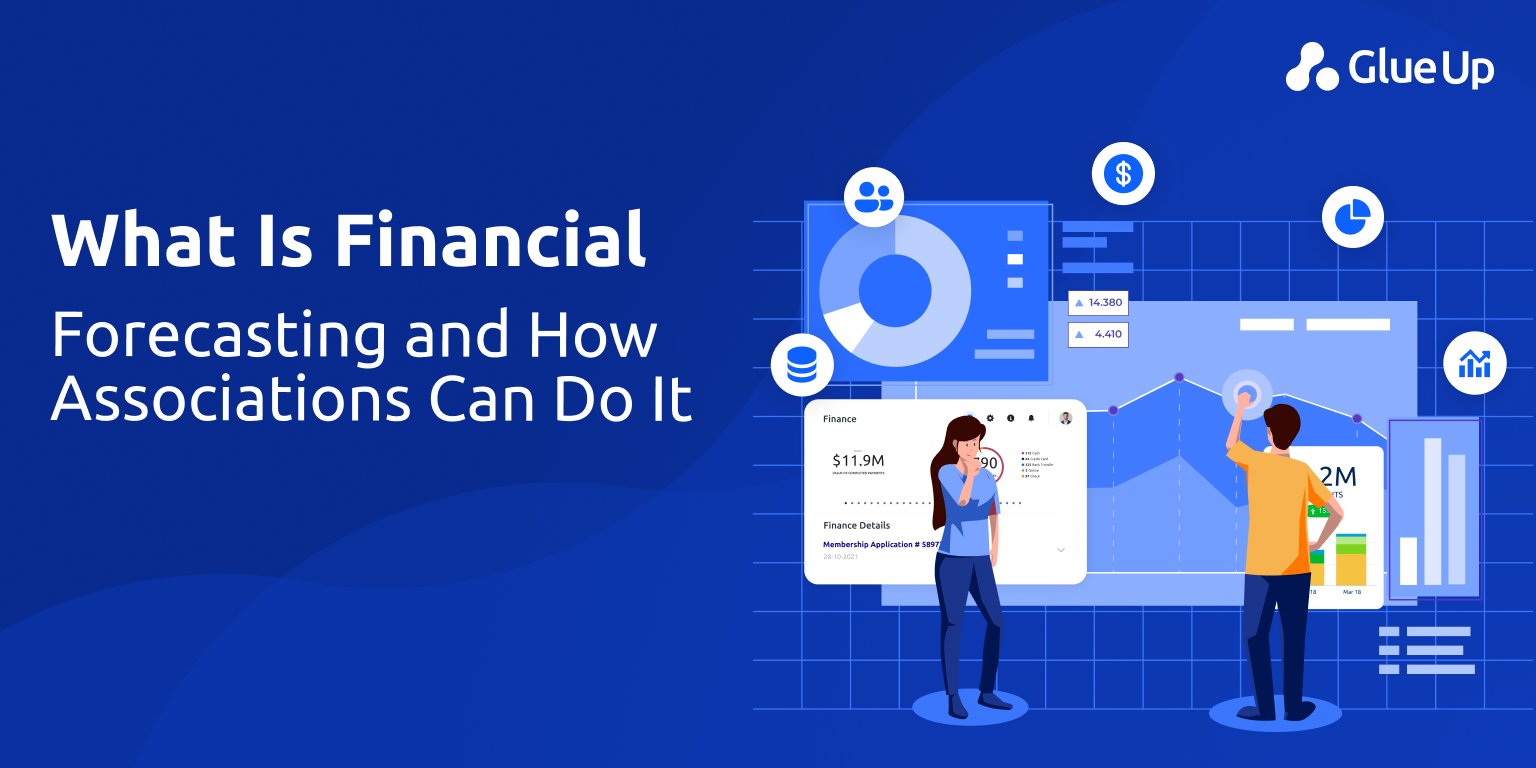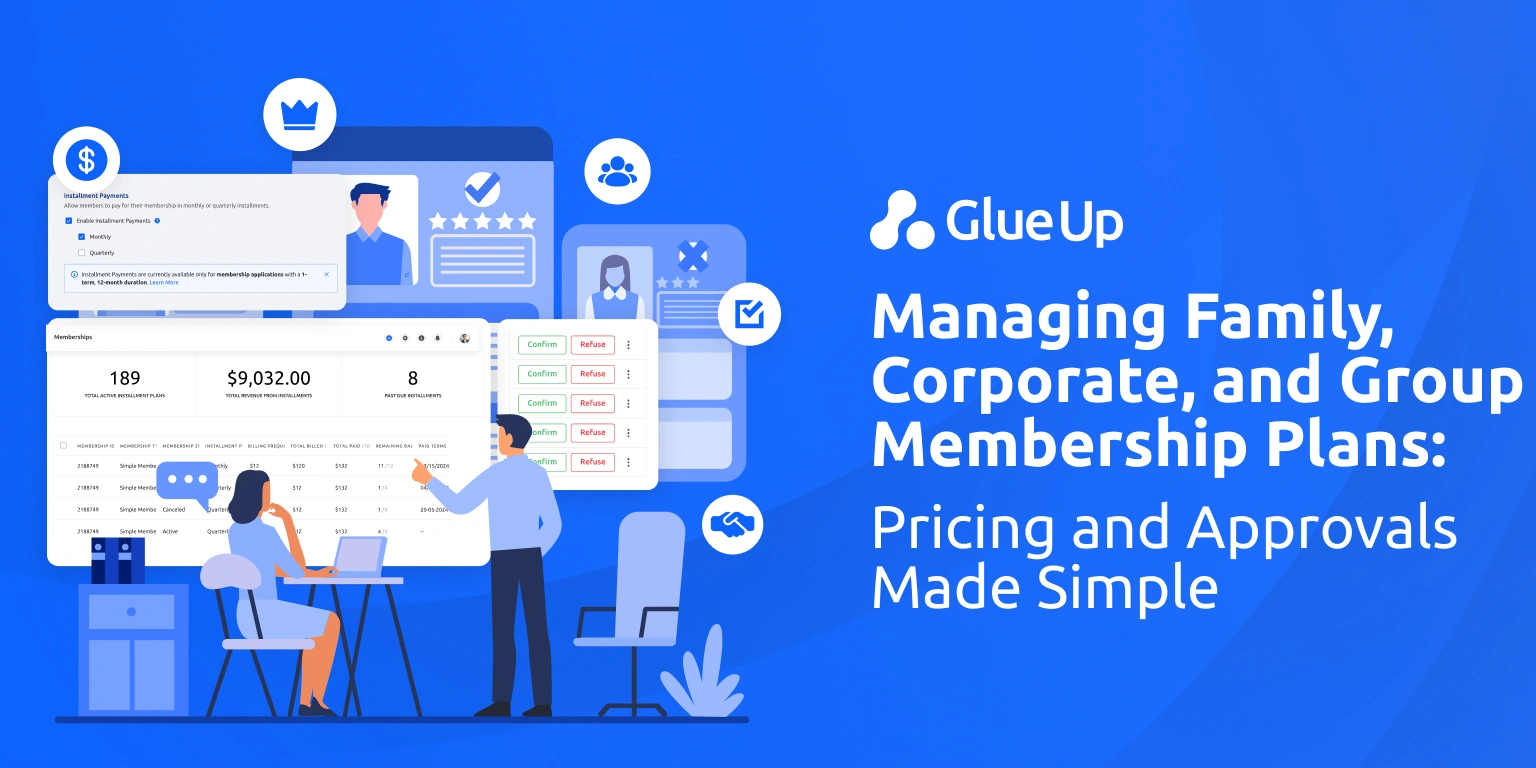
You have members who love your mission, but not everyone can drop a full year of dues in one payment. That is the moment you consider installments. The first question your board will ask is not philosophical. It is practical. How to model cash flow for installment plans so you have flexibility for members and stability for operations. This guide shows you the math, the policy levers, and the exact places to plug the answers into Glue Up so finance, membership, and events stay in sync.
You will see simple formulas. You will see real world assumptions about card fees, ACH growth, and failed payments. You will see how revenue recognition under ASC 606 is different from the timing of cash. You will also see why recovery of failed payments is a controllable variable, not a mystery, and why ACH adoption changes the fee math in your favor. The point is straightforward. If you can explain how to model cash flow for installment plans in seven lines, you can offer installments without starving programs in February.
Key Takeaways
The move from annual dues to installments changes cash timing, fee exposure, and failure risk. Build a simple, seven-input model first: member count, plan mix, price, payment method mix, processor fees, failure and recovery curve, and normal churn; so, you can see monthly net cash alongside recognized revenue.
Twelve small card payments cost more than one annual charge. Steering monthly payers to ACH, with autopay on by default, meaningfully lowers “fee per collected dollar” and smooths cash. A small incentive or ACH-only access to the base price is a practical lever.
A large share of churn is involuntary. Turn on account updater, set smart retry windows, and use friendly mutichannel dunning. Track a recovery curve, not just a fail rate, and aim to lift recovery month over month.
Under ASC 606, dues are recognized over time as benefits are delivered, while the cash pattern depends on annual vs installments. Maintain a clear deferred revenue roll-forward and a separate cash tab so finance, audit, and the board see the same truth.
Map each lever to the platform: plan type and payment preference fields, autopay toggles, ACH prompts, updater and dunning automations, grace-period rules, and dashboards for plan mix, fee per collected dollar, failure and recovery, and renewal forecasts by cohort. The model sets the targets; Glue Up makes the behavior stick.
Quick Reads
Why Installments Change the Way You Plan Cash and How to Model Cash Flow for Installment Plans
Installments change three things at once. First, they spread money across the year. Second, they multiply the number of payment events, which raises fee exposure and increases the chance of a decline. Third, they require discipline in how you recognize revenue over time versus when the money actually hits the bank.
Cash timing
Annual payers give you a fast spike. Installment payers create a slow river. You still recognize revenue over time under ASC 606 because members receive benefits across the year, but your cash no longer arrives up front. Guidance for nonprofits and membership programs treats dues as a set of performance obligations that are recognized over time as benefits are delivered, with any prepayments parked as deferred revenue. That is true whether you collect in one payment or twelve. The accounting pattern is ratable. The cash pattern is not.
Fee drags
Card transactions often cost a percentage plus a small, fixed fee. Multiply that by twelve and it adds up. Typical swipe fee ranges reported in the press and by industry explainers run roughly 1.5 percent to 3.5 percent with a per transaction component. ACH is usually cheaper on a per payment basis, which is why a small incentive to use ACH for monthly billing can have an outsized impact.
Failure risk and recovery
Not all churn is a choice. Many cancellations are involuntary because a card expired, was replaced, or was blocked. Research on subscriptions puts the share of churn from failed payments in the twenty to forty percent range, with recovery rates highly dependent on tooling, retries, and card updater services. Treat recovery as a dial you can turn, not a fixed tax.
The good news is that you can quantify all three in a small model. Once you can show how to model cash flow for installment plans in a simple table, your board conversation becomes calm and clear.
The Seven Line Spine That Explains How to Model Cash Flow for Installment Plans
You do not need a complex workbook to explain the plan. You need seven inputs. Build them into a month by month table. Each line here translates to a field or setting in Glue Up.
Members at start. Your active count on day one. Segment by plan if you want added precision.
Plan mix. What percent pays annually versus monthly or quarterly.
Price. Annual price A. Monthly price is A divided by twelve. Consider a small uplift for installments or require ACH to access the base price.
Payment method mix. Percent on cards versus percent on ACH in the installment cohort.
Processor fees. Card percentage plus per transaction, and ACH fee schedule. Keep these real by copying last month’s statement. Typical published ranges place swipe fees in the 1.5 percent to 3.5 percent band with a small fixed fee.
Failure and recovery. A first attempt failure rate, a retry schedule, account updater coverage, and expected recovery percentages across ten to thirty days. Studies show failed payments drive a material share of churn, and recovery varies widely by process.
Voluntary churn and new members. The normal adds and cancels you track already.
Monthly cash from installment payers then falls out cleanly.
Gross billed this month equals active installment members multiplied by A divided by twelve.
Fees equal card fees plus ACH fees based on your method mix.
Failures equal the first attempt declines minus the amount you recover through retries, updater, and dunning during the month.
Net cash equals gross minus fees minus net failures.
Keep a separate tab that recognizes revenue over time for ASC 606. You will allocate the annual dues across the service period and any discrete benefits like print journals or event admissions. That accounting view is for auditors and board reporting. The cash tab is for runway and bills. The two should never be confused.
Glue Up mapping is simple. Store plan type and method preference on the member record, turn on autopay, set dunning sequences, connect ACH, and enable account updater where available. Your model informs the settings. Your settings influence the model next quarter.
A Walkthrough Example That Shows How to Model Cash Flow for Installment Plans in Practice
Assume you have 10,000 members at the start of the year. Dues are 240 a year. Forty percent choose monthly. That gives you 4,000 installment payers at 20 a month.
Assume the method mix for installment payers is seventy percent card, thirty percent ACH. Assume card fees are 2.2 percent plus ten cents per transaction, and ACH costs thirty cents per transaction. These are placeholders. You should plug in your actual contract rates.
Assume first attempt card failures at nine percent. You use account updater and smart retries. Over ten days you recover sixty percent of those failures. Over the month, you recover a little more. You can push that curve with better timing, better messaging, and better methods. Benchmarks and vendor reports show how much lift is common with better recovery.
Now run the month one math.
Gross billed equals 4,000 times 20 equals 80,000.
Card portion equals 2,800 invoices at 20 equals 56,000.
ACH portion equals 1,200 invoices at 20 equals 24,000.
Card fees equal 56,000 times 2.2 percent plus 2,800 times 0.10 equals about 1,512.
ACH fees equal 1,200 times 0.30 equals 360.
First attempt failures equal nine percent of 56,000 equals 5,040.
Recovered in ten days at sixty percent equals 3,024.
Unrecovered in month one equals 2,016.
Net cash equals 80,000 minus 1,512 minus 360 minus 2,016 equals 76,112.
Repeat across twelve months, update the active count for normal cancels, permanent failures, and new members, and you now have a cash graph that shows the river of monthly money next to the spike of annual money. That picture changes the conversation with the board. It shows how to model cash flow for installment plans in a way everyone can see.
If you layer in revenue recognition, your accounting tab will show straight line recognition of dues over time, plus separate recognition for discrete benefits as delivered, just as ASC 606 requires for membership programs with multiple obligations. The cash tab and the revenue tab will look different. They should.
Policy Levers That Change the Curve and How to Model Cash Flow for Installment Plans with Them
Once you have the model, you can test levers.
Installment uplift or ACH requirement
Many associations keep the annual price as the headline and price installments at a slight premium or require ACH for the base price to offset fee drag. Because ACH has grown sharply and now supports faster same day rails at scale, member resistance is lower than it used to be, especially for business payers.
Nacha reported that Same Day ACH crossed 1.2 billion payments in 2024 with strong growth, and broader ACH network volume and value continued to rise into 2025. That trend makes ACH a credible default for monthly dues.
Autopay by default
Opt in friction kills adoption. Opt out friction kills retention. Set autopay on at sign up and be clear about the schedule. This small decision reduces human error and protects the cash line.
Account updater and smart retries
Cards expire, get replaced, or are reissued for fraud. Account updater services and intelligent retry windows recover a significant share of otherwise lost payments. Industry sources and vendor data place the share of churn from failed payments in the twenty to forty percent range. Recovery with basic systems can hover near half of those failures. With stronger systems, recovery can rise materially. Your own data will tell you what is possible.
Grace periods and pause options
For long tenured members, a short grace window preserves goodwill and raises recovery. For early career members, a pause option can prevent voluntary cancels in tight months. Price the privilege reasonably, and measure outcomes on renewals.
Event and education credits
If you bundle tickets or learning access into evergreen benefits, be sure the accounting tab allocates dues to those obligations correctly. The cash tab will not change. The revenue tab will. Nonprofit guidance and examples show how to allocate dues to stand alone benefits and recognize revenue at delivery.
Run each lever through the table. Show how to model cash flow for installment plans with and without each policy. The board will pick the mix that fits your mission and runway.
The Board Checklist That Proves You Know How to Model Cash Flow for Installment Plans
Bring this one-page list to finance committee, then to the full board. It reads fast and lands well.
Member need and adoption. Do members ask for installments because of cash flow, fiscal calendars, or employer reimbursement timing. What adoption rate are you projecting in year one and year two. Where will you pilot first.
Finance impact. What happens to cash if thirty to fifty percent of annual payers move to installments. What is the fee per collected dollar under your current method mix. What changes if fifty percent of monthly payers use ACH. Use the ACH growth data to support the adoption plan.
Risk controls. Is autopay on by default. Is account updater enabled. Do you have an intelligent retry schedule. Do you have a friendly dunning sequence across email and SMS. Do you capture a second method on corporate memberships.
Compliance and accounting. Are your performance obligations documented. Does your deferred revenue roll forward tie to delivery. Do promotions extend the recognition period as required under ASC 606. Bring a short memo or a reference that spells out the rule.
Member experience. Do you disclose the total annual cost side by side for annual versus installments. Do you explain the late payment policy in clear language. Do you send a short progress recap before renewal that makes value feel visible.
Glue Up mapping belongs right on the same page. Plan type and payment method on the profile. Autopay toggle. ACH prompt with a small incentive. Dunning schedule. Account updater. Renewal scorecards. Dashboard tiles that show plan mix, fee per collected dollar, failure and recovery, and renewal forecast for installment cohorts.
Mini Scenarios That Show How to Model Cash Flow for Installment Plans Across Different Associations
A state professional association
Adoption of monthly installments hits thirty five percent in year one. Finance sets a policy that the base price for installments requires ACH. Within two quarters, more than half of monthly payers are on ACH. Fee per collected dollar drops. Cash timing becomes steadier. Same Day ACH growth in the market makes the internal conversation easier because it feels familiar to employers and finance teams.
A regional chamber
The chamber turns on account updater and sets three intelligent retries within ten days. A friendly reminder goes out if the second retry fails, and staff calls high value corporate accounts at day twelve. Involuntary churn falls.
Recovery of failed payments rises from basic levels toward the higher ranges reported by platforms that focus on this problem. The model reflects the change within two months. The board can see the dollar impact of better recovery.
A national society with early career tiers
The society pilots a three-month installment plan for new graduates. Autopay is on by default. The offer includes a small education bundle and access to a member community. Because the revenue tab recognizes time based benefits over the extended service period, there is no accounting confusion. Because the cash tab includes the failure and recovery curve, the finance lead can set the right adoption target and still sleep at night. The pilot expands the following year.
Each scenario follows the same playbook. Show how to model cash flow for installment plans with current settings. Turn one lever at a time. Measure. Then decide.
The Glue Up Version of How to Model Cash Flow for Installment Plans
Here is the quick map from the model to the product.
Fields and preferences. Add plan type, payment method preference, and autopay status to the member record.
Payments. Enable ACH and present it first for members who choose monthly. The broader market now treats ACH as normal for business payments and it is growing quickly, which supports your adoption plan.
Automations. Turn on the dunning sequence you use in the model. Set retries at the same intervals you used in your assumptions.
Account updater. Where available, enable updater to reduce passive declines from expired or replaced cards.
Dashboards. Pin tiles for plan mix, fee per collected dollar, failure and recovery funnel, and renewal forecast by cohort.
Board exports. Use exports that show cash timing and recognized revenue on separate charts. Add a small table with policy levers and current settings.
The value of the tool is alignment. Every insight you discover when you learn how to model cash flow for installment plans becomes a toggle, a prompt, a chart, or a field that the whole team can use. No one is guessing.
The Short FAQ People Ask When They Learn How to Model Cash Flow for Installment Plans
Should installments cost the same as annual?
You can keep the headline price the same and require ACH for installments to hold that price. Or you can add a small premium for installments to cover fees and administration. Test both and let adoption and fee drag guide the decision.
What adoption rate should we plan for in year one?
Many associations see twenty to forty percent adoption when they present installments clearly and when autopay is on by default. Run the model at two points so your board sees the range.
What is a good failure recovery rate?
Basic dunning and retry setups often stop near half of initial failures. With smarter timing, updater, and better messaging, you can push higher. Treat this as a system, not a hope.
Why does ACH matter so much?
Each monthly payment has a fee. ACH is often cheaper than cards, and Same Day ACH has grown into a mainstream option. A small incentive on sign up can move method mix and meaningfully lower total costs across the year.
How does revenue recognition work if we add an extra month or bundle an event ticket?
Under ASC 606 you recognize revenue as you deliver benefits. If you add a free month, you spread recognition across that month too. If you bundle a discrete event, you allocate part of the dues to that ticket and recognize it when the event occurs. This is normal and expected.
The Human Part of How to Model Cash Flow for Installment Plans
People join because they want progress in their work, not because they love billing choices. Installments are a courtesy that meets people where they are. The model is the safety belt that keeps the organization solid. If you get the math right, you can say yes to more members without saying maybe to your staff payroll or your policy work.
That is why the first graph you show the board is not a generic budget. It is two lines. One line shows the monthly cash from annual payers and installment payers together under the current mix. The other line shows the same picture if adoption rises to the level, you believe is likely when you present the plan cleanly.
Beside the graph, list the levers you will pull. ACH by default for monthly. Account updater on. Three intelligent retries. Friendly reminders. A short grace period for long tenured employers. A pause option for early career professionals.
Add one more box with your assumptions and your sources. Your fee schedule. Your last quarter failure rate by decline type. A brief note on ASC 606. A quick line about ACH adoption and the rise of Same Day ACH that makes faster processing more useful for retries and timing. Nacha’s recent reports give you the external proof.
When you present this clearly, the conversation changes. A board member who was nervous becomes confident because it is clear you understand how to model cash flow for installment plans and how to manage risk. A membership director who wanted to try installments for years finally has a green light. A finance lead who worried about February cash can see the river flowing through the year.
Where The Numbers Come from and Why They Matter
A quick note for the person who wants citations before they sign. Revenue recognition for dues is an ASC 606 topic. Nonprofit guidance and professional explainers are consistent on treating membership benefits as performance obligations recognized over time, with prepayments recorded as deferred revenue until benefits are delivered. If you add a free month, the recognition period extends. If you allocate a ticket, you recognize that portion at the event. This keeps your books clean and your auditor happy.
On the payments side, public reporting and explainers place card fees in the one and a half to three and a half percent range plus a per transaction amount, subject to your contract and card mix. ACH has grown fast, with Same Day ACH crossing major volume and value milestones in 2024 and 2025, which supports adoption in business-to-business settings.
Payment failure and involuntary churn have been studied widely in subscription contexts. The headline is the same across sources. A large share of churn is avoidable with better retries, updater, and dunning. Treat recovery as a program you manage, not a penalty you accept.
This is why the model matters. It lets you translate public facts and your own data into a plan that fits your association, your chamber, or your society. When you know how to model cash flow for installment plans, you can decide with precision, not vibes.
Your Next Step and a Small Challenge
Open a sheet. Enter seven lines of inputs. Build the month-by-month table. Show the two charts. Bring the one-page checklist. Then turn the settings on inside Glue Up and watch your dashboard tiles move over the next quarter.
If your fee per collected dollar falls, if your failure recovery rises, if your cash line looks smoother, say so in your board report. If a lever underperforms, say that too and adjust. This is continuous improvement, not a one-time bet.
If you want a nudge, try this small challenge. Pick twenty members who already love you and who renew every year. Offer them monthly with ACH and autopay for the same price. Run the numbers for two months. Share the chart with your team. The conversation will shift from whether to offer installments to how to model cash flow for installment plans at scale because you will have proof that is yours, not borrowed.
Installments are a kindness. The model is the safety belt. Glue Up is the place you turn the decisions into fields, automations, and dashboards that your whole team can follow. When you can explain how to model cash flow for installment plans in seven lines, you can say yes to flexibility and yes to fiscal discipline at the same time. And that is the kind of answer that keeps members, staff, and your board on the same page.



